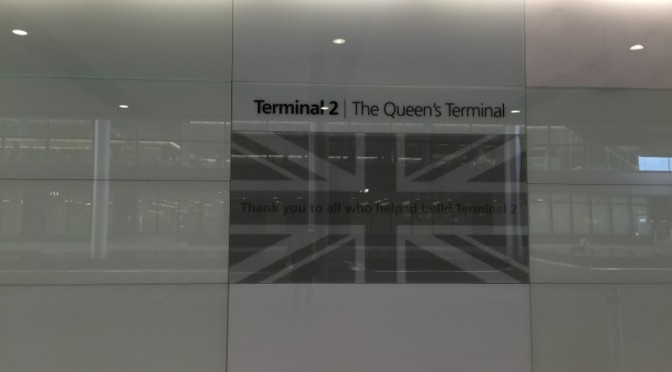There’s good news about living in Harrow: We’re only two bus stops away from a rental car station. But now for the bad news as well: it’s closed Saturday afternoon and Sunday all day.
And sometimes, life calls for that trip to central London on Sundays — on more flexible timing than what the Tube offers you. So where do I get my car? Heathrow Airport. Thankfully, you get to choose where you pick your car up — you in essence arrive at any terminal, then choose the desk of your car rental company.
I decided to give the recently re-done Heathrow Terminal 2 a try some weeks back before I headed to my rental car company at the airport. (Coincidentally, I have now mastered this skill I once thought was impossible — driving a manual / stick-shift in the UK — I can do this as one of my licences is a full one for manuals as well.)
I can’t really speak for Terminal 2 as a full experience, since Tracy and I have yet to catch a flight there (plus British Airways doesn’t fly out from Terminal 2, so it’s the Speedbird terminal AKA Terminal 5 for most BA flights). But I did get a chance to grab a quick bite at the landside Terminal 2 cafés.
The one thing that comes to you after 14 years in China is this perception that all airports have to be big. Chengdu’s Terminal 2 certainly stunned us, as it took us forever to get from the plane to our taxi rank at the exit. (Barcelona El-Prat was huge as well, but at least it was more compact.) So I was looking for Heathrow’s latest addition to be huge, certainly landside. After all, this came after Beijing Capital International Airport’s Terminal 3, so it had to be inspired by China, or aspire to be of similar dimensions. Right?
Wrong.
Heathrow Terminal 2’s dimensions left me wanting for more. There was only this bit of the airport at the departures level where you had a bite (and even so, you had to head out of the main building into a covered “midway piazza” to change levels). There was woefully little for you at the arrivals level, and the fact they couldn’t exchange Macanese patacas wasn’t too encouraging either.
Contrast that with Beijing’s Terminal 3: there is a Starbucks that occupies probably 20% of the whole Arrivals area. I’ve met tonnes of visitors from especially the US in that part of PEK T3. It gave you a place to “belong to”, as it offered options “just in case” you needed something at the airport. The fact that Level 4 now comes with a railway ticket office for Chinese trains is a very cool new addition. And for those of us who would prefer something more British, there’d be a Costa at Departures Level as well, which was in fact where we entertained (quite coincidentally) British TV executives at the China-UK summit on TV formats about half a year back.
I’m not saying Terminal 2 “is through”; it isn’t, and for a terminal that opened less than 4 months ago, I’m sure there’s a lot more in store. I was expecting maybe a major brand name café a la Terminal 5 at the Arrivals Level (you at least got something from Costa before heading onto the Heathrow Express). But big name café chains aside, Terminal 2’s arrivals level feels tiny. Not that you had to have sofas at the arrivals level (PEK doesn’t come with that either). But it gave you a feel: This is as big a terminal as we have. Which for the world’s leading industrialised nation doesn’t say a lot.
(But then again, for the real Britain, you’d head outside of Heathrow.)
I’m thoroughly impressed by Terminal 2’s wide open spaces, but less so with regards of what the terminal building itself has. For the newest terminal building of the capital of the UK, I thought I’d be seeing something a little larger, with more on offer. Maybe it’s because I’ve been spoilt rotten by Chinese airports. Or maybe @ LHR T2 it’s still earlier days.
But I’ll still be thankful for the Costa at the Departures Level at Terminal 2. I know I’ll need to get work done on those long flights. Thank heavens I know there’s a Caffeine Charging Station. Plus to have the ultimate word on T2, I’ll need to get out of (or fly into) London from that terminal.
I hope when I’m airside, I’ll be positively surprised.
PS: I am starting to get used to the “duo-tone” airport jingle at Heathrow…
